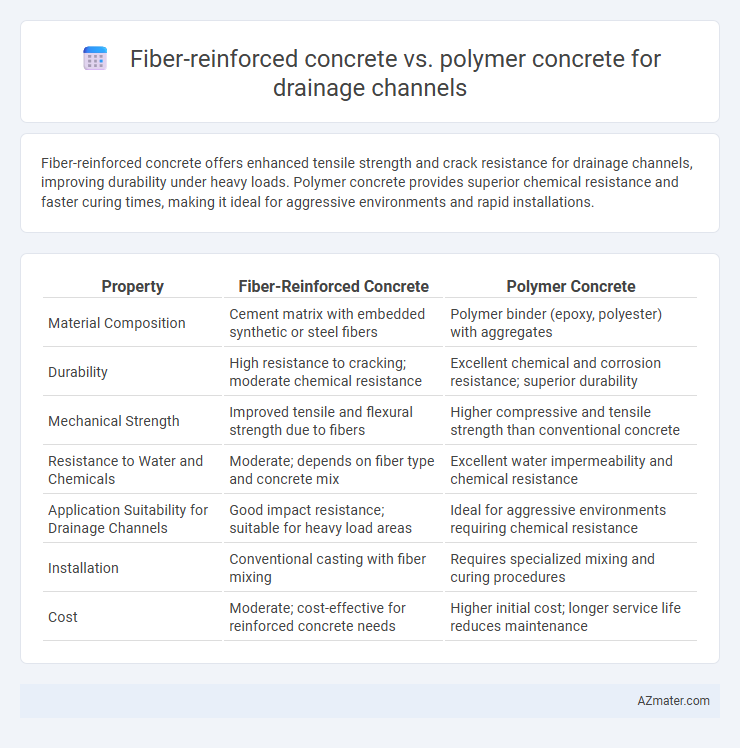Fiber-reinforced concrete offers enhanced tensile strength and crack resistance for drainage channels, improving durability under heavy loads. Polymer concrete provides superior chemical resistance and faster curing times, making it ideal for aggressive environments and rapid installations.
Table of Comparison
| Property | Fiber-Reinforced Concrete | Polymer Concrete |
|---|---|---|
| Material Composition | Cement matrix with embedded synthetic or steel fibers | Polymer binder (epoxy, polyester) with aggregates |
| Durability | High resistance to cracking; moderate chemical resistance | Excellent chemical and corrosion resistance; superior durability |
| Mechanical Strength | Improved tensile and flexural strength due to fibers | Higher compressive and tensile strength than conventional concrete |
| Resistance to Water and Chemicals | Moderate; depends on fiber type and concrete mix | Excellent water impermeability and chemical resistance |
| Application Suitability for Drainage Channels | Good impact resistance; suitable for heavy load areas | Ideal for aggressive environments requiring chemical resistance |
| Installation | Conventional casting with fiber mixing | Requires specialized mixing and curing procedures |
| Cost | Moderate; cost-effective for reinforced concrete needs | Higher initial cost; longer service life reduces maintenance |
Introduction to Drainage Channel Materials
Fiber-reinforced concrete offers enhanced tensile strength and durability for drainage channels, improving crack resistance and longevity under heavy load conditions. Polymer concrete provides superior chemical resistance and rapid curing times, making it ideal for corrosive drainage environments and accelerated construction schedules. Selecting the appropriate material depends on project-specific factors such as load requirements, environmental exposure, and maintenance considerations.
Understanding Fiber-Reinforced Concrete
Fiber-reinforced concrete (FRC) enhances drainage channel performance by integrating synthetic or steel fibers into the concrete matrix, significantly improving tensile strength, impact resistance, and crack control compared to polymer concrete. FRC exhibits superior durability against freeze-thaw cycles and chemical attack, making it ideal for harsh environmental conditions typical in drainage applications. Unlike polymer concrete, FRC maintains better flexural toughness and cost-effectiveness, ensuring long-term structural integrity and reduced maintenance.
Key Features of Polymer Concrete
Polymer concrete for drainage channels offers superior chemical resistance and rapid curing times compared to fiber-reinforced concrete, making it highly durable in harsh environments with exposure to acids and alkalis. Its high compressive strength and excellent adhesion to reinforcements reduce permeability and enhance structural integrity under heavy load conditions. The lightweight nature and ease of molding allow for precise fabrication of complex channel shapes, improving installation efficiency and long-term performance.
Strength and Durability Comparison
Fiber-reinforced concrete (FRC) exhibits superior tensile strength and crack resistance due to the embedded fibers, enhancing the overall load-bearing capacity of drainage channels compared to polymer concrete. Polymer concrete, composed of resin binders and aggregates, offers exceptional chemical resistance and durability in corrosive environments but generally has lower flexural strength than FRC. When selecting materials for drainage channels, FRC provides better impact resistance and structural integrity, while polymer concrete excels in longevity under aggressive chemical exposure.
Chemical and Corrosion Resistance
Fiber-reinforced concrete exhibits superior resistance to chemical attacks and corrosion due to its densely packed matrix and the presence of fibers that limit crack propagation, making it highly effective in aggressive drainage environments. Polymer concrete offers exceptional chemical resistance, especially against acids and alkalis, due to its non-porous polymer binder that prevents ingress of corrosive substances, ensuring long-term durability in drainage channels exposed to industrial effluents. Both materials enhance durability in drainage applications, but polymer concrete provides a higher level of protection against aggressive chemicals, while fiber-reinforced concrete combines mechanical strength with moderate chemical resistance.
Installation and Workability
Fiber-reinforced concrete offers enhanced workability due to the even distribution of fibers, which improves mixing and placement in drainage channel construction. Polymer concrete provides superior flowability and quick curing times, facilitating faster installation and reduced labor costs. Both materials ensure durability, but polymer concrete's lighter weight and chemical resistance often result in more efficient handling and installation in complex drainage systems.
Cost Analysis: Fiber-Reinforced vs Polymer Concrete
Fiber-reinforced concrete typically offers a lower initial material cost compared to polymer concrete, making it more budget-friendly for drainage channel projects. Polymer concrete, while more expensive upfront, provides superior chemical resistance and durability, potentially reducing long-term maintenance expenses. Evaluating total lifecycle costs reveals fiber-reinforced concrete is advantageous for projects with tight budgets, whereas polymer concrete suits environments demanding extended service life and minimal repairs.
Maintenance and Longevity
Fiber-reinforced concrete offers enhanced crack resistance and durability in drainage channels, reducing maintenance frequency due to its ability to withstand mechanical stresses and environmental exposure. Polymer concrete exhibits superior chemical resistance and impermeability, leading to lower degradation rates and longer service life in aggressive drainage environments. Choosing fiber-reinforced concrete improves structural integrity, while polymer concrete minimizes maintenance costs through extended longevity in corrosive conditions.
Environmental Impact and Sustainability
Fiber-reinforced concrete (FRC) enhances durability and reduces maintenance for drainage channels, lowering the environmental footprint by minimizing material consumption and waste over the structure's lifespan. Polymer concrete incorporates resins and aggregates, offering chemical resistance and rapid curing but relies on non-renewable petrochemical components, raising concerns about sustainability and recyclability. Selecting FRC supports eco-friendly infrastructure through longer service life and potential incorporation of recycled fibers, while polymer concrete demands careful consideration of polymer sourcing and end-of-life disposal impacts.
Choosing the Right Material for Drainage Channels
Fiber-reinforced concrete offers enhanced tensile strength and crack resistance, making it ideal for drainage channels subjected to heavy loads and temperature variations. Polymer concrete provides superior chemical resistance and rapid curing, which benefits environments with aggressive wastewater or where fast installation is critical. Selecting the right material depends on factors such as load-bearing requirements, exposure to chemicals, installation speed, and overall durability for long-term drainage channel performance.

Infographic: Fiber-reinforced concrete vs Polymer concrete for Drainage channel
 azmater.com
azmater.com